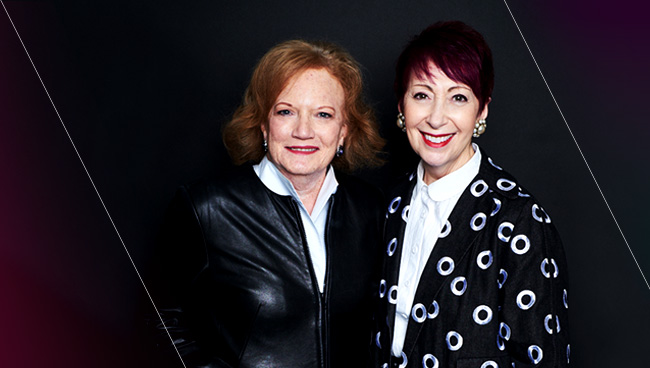In this episode:
Wendy Liebmann and Candace Corlett, WSL Strategic Retail’s managing partners, discuss key shopper insights from the first six months of the pandemic, surprises and new realities, and how retailers and brands must now move forward. In this first segment of a three-part discussion, they answer the burning question: Will shoppers ever go back to the store?
Wendy [00:00:02] Hello, my name is Wendy Liebmann on the CEO and chief shopper of WSL Strategic Retail. And this is Future Shop. This is where I always have a Fast and Furious chat with guests about the future of retail and what companies need to do to envision that future.
Wendy [00:00:21] And if ever there was a moment for us to consider this, it is now. My guest today is my business partner and dear friend, Candace Corlette. Hello, Candace. Good morning, Wendy. How are you?
Candace [00:00:34] I’m really good.
Wendy [00:00:35] Good. Normally that’s the first question I ask. Hello. How are you? Where are you? But since I’ve already spoken to this morning, I know all of it for everyone listening. You know, for over 20 plus years, Candice and I have worked together to help our clients anticipate, change and build strategies for the future and as you know, very focused through the lens of the shopper.
Wendy [00:00:58] So we are the shopper advocates and Candace is the shopper advocate supremo in our company whose focus is always around. What are the questions we have to ask? What’s the intelligence our clients need? How does America shop and how do we think about what comes next? So Candice and her team are always focused on that all day, every day. So who better to talk to about where we are?
Wendy [00:01:27] So the topic of this podcast is here we are six months in. What do we know? And, you know, Candice and I, when we did our very first podcast last year, the subject was it’s not about Amazon. And here we are six months later.
Wendy [00:01:44] And actually maybe it is. So anyway, what we’re going to do today is really talk about what we’ve seen over the last six months, what we see for the future surprises, silver linings, biggest opportunities and winners and losers. Because, you know, with us, we’re always happy to tell you when your children are ugly and what you are not doing right as well as what you are.
Wendy [00:02:07] So we have so much to talk about here. And Candace and I always do, but we’re very conscious of your time now. We know you’re not commuting most of you, and you’re doing more of video conference calls than ever before.
Wendy [00:02:20] So rather than do this whole long episode, but we’ve decided to do here is break it into some conversations, three episodes short, sharp-ish that you’ll be able to absorb in more efficient ways. We’re going to do three episodes or as I call them, chapters. Chapter one. It’s all about how seldom do I really need to go to a store anymore? Chapter two, we’re going to talk about how shoppers have reset their lives. Yes, already. And we cannot long for the past anymore. And chapter three, what comes next? So now chapter one. How seldom do I actually have to go to the store anymore to begin at the beginning?
Wendy [00:03:04] Candace, six months ago. So, you know, what have we learned?
Wendy [00:03:08] What have we learned? What have you learned?
Wendy [00:03:10] You know, personally, business-wise, you know, what’s your first off the top of your head? Six months behind us.
Candace [00:03:20] You know, I think the most startling thing I personally learned and that we’re seeing reflected across the country is how seldom I need to go to the store. I don’t know whether I take pride or it’s more wonder in how everything has been delivered to my door. And after the first couple of months of, oh, what will I be able to get it turned into? OK, so let’s step back and put my WSL hat on and start evaluating who’s doing this really well and who, as you said, is just not in the game, not delivering well. So for me, the personal satisfaction has been everything I’ve needed has been delivered to my door looking at our shoppers across the country. I’m not alone. So many people have stepped up and said, maybe I’ll try that delivery and see if I can get my peanut butter. And all sharing this sense of wonder that it’s working. So I’m kind of intrigued.
Candace [00:04:35] And how many shoppers across the country share my view that you can get all the basics delivered really well.
Wendy [00:04:43] It’s interesting you say it, because I do remember from the very end, the very beginning, having sort of because of the issues of delivery. And I was already an online shopper for groceries and most of the time and the accessibility of getting stuff delivered. And I think I had carts full, but not with any delivery time from fresh direct from Amazon, fresh from Instacart, you know, all of that. And I couldn’t get it delivered. So I actually had to go out into the stores and engage there because here I was at Manhattan with nothing being delivered. And it was a challenge. And it was very interesting. So to your point, you know, now I could get deliveries in a minute, which I just did, but that learning about that, the accessibility. And on the other hand, for me it was also I actually store was the physical store was still really important.
Candace [00:05:43] I thought the physical store was very important to me, too. And I braved. Going into my local supermarket that I used to consider an adventure. I went in last week, and when I got home, I said, why did I do that? So many of those. I was still surprised at the out of stocks on the shelves. I mean, something as basic as mayonnaise. The entire shelf is empty.
Wendy [00:06:06] It’s not just about paper products.
Candace [00:06:08] I no, it’s not a supply chain, as we know from our clients, has been a big issue. And supply chain has been an issue for just basic groceries as well as the infamous toilet paper.
Candace [00:06:21] Why did I spend an hour and a half wandering the aisles of the grocery store? I just don’t need to do that anymore.
Wendy [00:06:29] You know what’s interesting about that? And we’ve talked a lot about things and we’ll talk about it some more about the relationships and the value of the people who work in the stores and the essential workers and all of that. One of things I have learned in this just personally, is there is a grocery store that I go to on the weekends in New Jersey. And the reason I still like to go there, it’s all about the people, you know, the people who say good morning. How are you? You know what’s going on. How are you managing? And it is that sort of intimate connection. Now, when it comes to the drugstore, I could care less. Sorry, drugstore clients. I could care less, but it is where I have a relationship. So I think those things, as we think about it, for our clients to that notion of, you know, where is that human touch important and where is this? Let me just get it off the list and get it done. So I don’t have to think about it. And I can think about other things, which, of course, was something we were seeing way before the pandemic.
Candace [00:07:27] Right. Well, the human touch is what I went back to the supermarket for. But, it’s very, very deluded. First of all, we’re all wearing masks. Even people who are recognized didn’t stop to chat because the goal is to get this done quickly with little contact. The check out people, I’m sure there’s been a lot of transition in the six months because I just have not been there. They were different, but they’re all behind plastic screens and wearing masks, which is as it should be. And maybe that’s part of why it was. I just don’t need to do this anymore. So I think we you know, we’re already seeing this high level of satisfaction with delivery among shoppers for the basics. This has been the transition, the basics. I mean, you know, most of us have been right in there buying our shoes and clothes and everything else online. But for the basics, it’s a new transition.
Wendy [00:08:34] And I think that the big you know, what struck me about all of this over this six months is so many of the things that we had been talking about in all our how America shops work, these sort of foundational shifts that we’ve been nagging clients about forever. And we are sometimes nags about this came into play. Right. The sort of saved me time. Let me get it off the list so I can now do other things. You know what’s really, you know, digital being a a tool both in terms of knowledge, understanding, pre shopping, and for many in certain categories, shopping, the whole focus on health and wellness. I mean, all of those things or and challenges around trust. All of those things were sort of ingrained before we got to the pandemic. And it seems that this sort of pandemic has just, you know, people I’ve met Parry when I did the podcast with him a couple of weeks ago from Wal-Mart, talked about this sort of shifted all this five years. You know, it just sort of ratcheted it up. So we are now in like twenty, twenty five. Is that the thing that you see, there was so much already in place that people could adopt quickly?
Candace [00:09:45] Well, thank you for opening that Segway. You knew it would be difficult for me to get through a podcast without mentioning some numbers. Back in 2017, we were telling our clients that almost 60 percent of shoppers said, I want to get my basic shopping done faster. So I have time to spend on other things that I want to do. And that might be more shopping. But not for the basic essentials that they need. We already knew the two thirds of people were pre shopping in order to make their trip in the store faster. So everything was in place. In 2017.
Candace [00:10:24] There was hesitation. I mean, and I think on the part of the retailers who were so connected to the Target, Wal-Mart, the supermarket chains, they knew that a very low percentage of the basic groceries, home supplies went through online buying. It was increasing, as you said, you know, creeping up. But this pandemic took a lead and I don’t think they were ready.
Wendy [00:10:54] And I think you’re being polite. Sorry to interrupt, but they were not ready.
Candace [00:11:01] They tried. But I mean, I watched Wal-Mart go from sending me a bag of potato chips and a massive box. That’s the only thing that was in the box. And my order dribbled in over two weeks. And now they’ve got it down to two days. Target has gotten so good at curbside pickup. I don’t know if I’ll ever go in a Target store again. And that’s, you know, like I want to. And maybe I will. I’m sure I will, because I’ll be curious. I love their dollar section when you walk in and the notions, the handbags, the fashion that they have. But for basics targets my go to place. I drive up. They come right out. They put it in my trunk. And they’re not even allowed to accept a tip. Which is a little sad because those kids work hard.
Wendy [00:11:51] You know, so this is one of the big issues and sort of leaping forward. You know, one of the things that you and I have talked about for a long time, and I remember we did some future of strategy work for one about a large global beauty clients, where we said to them, and this was five, six, seven years ago. You have to consider now here’s a scenario. One hundred thousand stores that you’re in gone or that that freak them out. OK. Ten thousand stores that you’re in are gone now. And I think one of the really big issues we are raising and we’re seeing in our work is that, in fact. How many stores do we need? How many stores of how much size in the store. Do we need? How much space do we need for the products and services that or at least the products that we’re selling? And that whole moment now of retail, which was really a real estate business, was all about location, location, location, and how many stores do we have? And I think what you’re saying now, it’s not just about us. We’re seeing with our shoppers, what from shoppers across the country, that that is a whole reset. Right.
Candace [00:13:01] Well, that’s right. I mean, in one of our COVID reports, I guess The Reopened Society report, I was shocked at how many people were really satisfied with, you know, high percentages, 60, 70 percent satisfied with the services they were getting. And the concern about why we’ll be able to get more sales when they might not get low prices. They figured that out. And hats off to the retailers. I think they had the Web site in place to let people shop sales and to remember what they bought last time. It was the logistics of them packing it and shipping it that they weren’t prepared to do. So I think the retailers, with a lot of support from our manufacturer friends, build-out Web sites that were ready. Now they’re catching up with logistics.
Wendy [00:13:54] And that raises the issue that you talked about with order online pick up at the store. Right. So, so many of the certainly in the CPG categories. But even in fashion, beauty, certainly, where there’s that notion of browsing, that that physical sense of, you know, that’s wandering down the aisles. I mean, physically and seeing what’s new. So now all of a sudden, many of us and we’ve got all that data around people who bought online and categories for the very first time and say they will stick with that. But that notion of the store, the physical store, is a place where you see new and your you know, you get your chores done, but then you wander down the other aisle, whether it’s, you know, Target or it’s, you know, Bloomingdale’s or oh, heavens, let’s talk about department stores today. But wherever it is. That changes the dynamic of the shopping journey now. Right.
Candace [00:14:47]
You know, I’ll take a little issue with the concept of roaming down the aisles to see what’s new. I think we’ve seen in all our work for the last three years that there’s a huge mediocrity in choice itself. And I don’t think shoppers roam down the mayonnaise, the condiment. The shampoo aisle. Expecting to see a new jump at them. And if it is presented as new, there is the pushback. Is it really new? And we’ve seen in our work that new is now reserved for what we call the ankle biter brands, the innovators who appear on the shelf. And it’s like, wow, they are really new. So I think the journey to the store in anticipation of finding something new. I don’t think that’s a big motivator. You’re more up to find new on the retailers Web site.
Wendy [00:15:49]
So that’s really interesting because there’s another fundamental thing that was in place before the pandemic.
Wendy [00:16:02]
It’s clear we can’t live in our old world anymore. And that’s what we’ll talk about in the next episode. How shoppers have reset their lives. Yes. Already. So join us for episode two. See you in the near future.

















